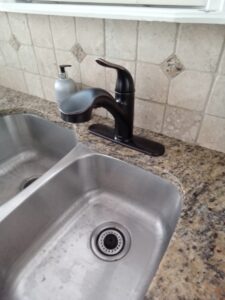Why Is My Faucet Dripping?

A dripping faucet is more than just an annoyance—it can waste gallons of water, increase your utility bill, and even lead to potential plumbing issues if left unchecked. According to the EPA, a faucet that drips once per second can waste over 3,000 gallons of water per year! If you’ve noticed that your faucet won’t stop dripping, here are some common causes, what they mean, and how you can fix them.
Common Causes of a Dripping Faucet
1. Worn-Out Washer or O-Ring
One of the most common reasons for a dripping faucet is a worn-out washer or O-ring. These small rubber components act as a seal between moving parts, preventing leaks. Over time, washers and O-rings can wear down due to friction, causing water to seep through. This issue is particularly common in compression faucets, which rely on washers to control water flow.
Signs of a worn-out washer:
- Dripping occurs when the faucet is turned off
- The drip is steady and consistent
- You hear a slight squeaking noise when turning the handle
Fix: Replacing a washer or O-ring is a relatively simple DIY fix. You’ll need to disassemble the faucet, remove the old washer, and install a new one that fits properly. If you’re unsure about the right size, bring the old washer to a hardware store for a match.
2. Corroded or Faulty Valve Seat
The valve seat is the part that connects the faucet and the spout. Over time, mineral deposits from hard water can build up, causing corrosion and leaks around the spout area. If left unaddressed, a corroded valve seat can lead to more severe plumbing problems.
Signs of a corroded valve seat:
- Water leaks from the base of the faucet
- The faucet handle feels rough or stiff when turning
- Visible mineral buildup around the faucet
Fix: Regular cleaning with vinegar or a commercial descaler can help remove mineral buildup and extend the lifespan of your valve seat. If the corrosion is severe, the valve seat may need to be replaced.
3. Water Pressure Issues
If your faucet drips at certain times of the day or only when other water fixtures are in use, fluctuating water pressure could be to blame. High water pressure can prevent water from fully shutting off, leading to a slow, intermittent drip.
Signs of water pressure issues:
- The faucet leaks at random times
- The drip becomes worse when other fixtures are turned on
- Pipes make noise when water is running
Fix: Check your home’s water pressure using a gauge. If the pressure is too high (typically above 60 PSI), you may need to install a pressure regulator to keep it at a safe level. A professional plumber can assess the issue and provide the best solution.
4. Broken or Worn-Out Cartridge
If you have a modern faucet, it likely has a cartridge inside that controls water flow. A faulty or worn-out cartridge can cause continuous dripping even when the handle is fully turned off.
Signs of a faulty cartridge:
- Water drips from the spout even when turned off
- The faucet handle feels loose or unresponsive
- Uneven water flow when turning the faucet on
Fix: Replacing a cartridge requires shutting off the water supply, removing the faucet handle, and installing a new cartridge that matches your faucet’s model. This repair can be DIY-friendly, but if you’re not comfortable with plumbing work, our professionals can do it quickly.
5. Loose or Damaged Plumbing Components
Over time, plumbing connections and components inside the faucet can loosen or wear out, causing small leaks that lead to a persistent drip.
Signs of loose plumbing components:
- Water leaks from the base of the faucet or under the sink
- You notice movement when touching the faucet
- The faucet drips inconsistently
Fix: Check for loose nuts or bolts around the faucet assembly. Tightening them with a wrench can sometimes stop the leak. If parts are damaged, they may need to be replaced.
Why You Shouldn’t Ignore a Dripping Faucet
A dripping faucet isn’t just a minor inconvenience—it can have several consequences:
- Increased Water Bills: Even a slow drip can add up over time, wasting gallons of water and increasing your costs.
- Water Damage: Constant dripping can lead to moisture buildup, potentially damaging sinks, countertops, and surrounding areas.
- Mold Growth: Persistent leaks create a damp environment that promotes mold and mildew growth, which can be hazardous to your health.
- Worsening Plumbing Issues: What starts as a small drip can indicate a bigger problem down the line, leading to more expensive repairs.
How to Fix a Dripping Faucet
While some fixes, like replacing a washer, can be done DIY, more complex problems—like a faulty cartridge or corroded valve seat—may require professional assistance. If your faucet is still dripping after basic troubleshooting, it’s best to call a professional plumber to assess the issue. And we just happen to know a company we can recommend 🙂
Need Help? Call Schrader Plumbing!
If your faucet won’t stop dripping, let the experts at Schrader Plumbing help. We provide fast, reliable faucet repair and replacement services in the Tarrant County area. Whether it’s a simple washer replacement or a more complex plumbing issue, we’ve got you covered.
📞 Call us today at 817-262-0989 or visit Schrader Plumbing to schedule an appointment!
Categories: Faucets,By: Michelle Kurcina
Last modified:
Last Modified: April 17, 2025 at 4:09 pm


